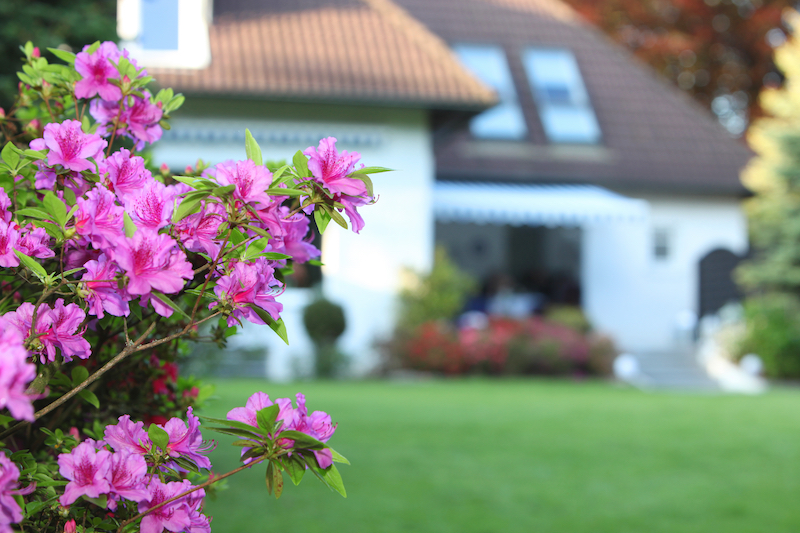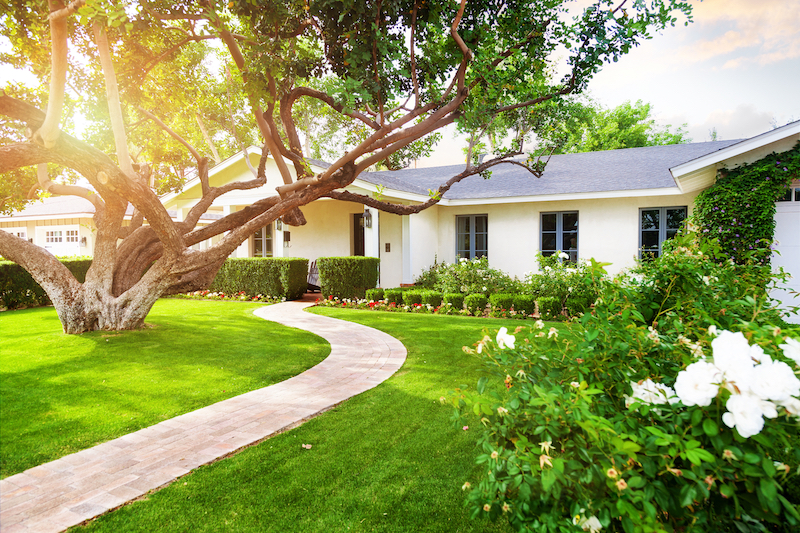
After the wrath of winter, many homeowners look forward to getting outside to begin caring for their lawns. Check out this landscape maintenance schedule we’ve compiled to assist you:
March
Lawns: For acid soil, lime your grass every couple of years. Use a soil test to find out how much to apply or 15 to 20 pounds of lime per 100 square feet of lawn area.
Planting: Prepare planting beds for veggies, herbs and flowers. Apply a one- to three-inch layer of compost and work it into the upper three inches of soil.
Azaleas: If azaleas aren’t planted by color, after they finish blooming, consider rearranging them by color for maximum effect, then prune and shape them for a better display next year.
Pruning: Cut back ornamental grasses and old perennials before the new growth begins to appear. Compost the debris.
April
Mulch: Remove and replace or freshen mulch.
Lawns: Begin regular mowing, and trim only about the top third of the grass blades.
Perennials: As soon as the new growth appears, divide and plant out perennials that bloom mid-summer through fall, such as daylilies, black-eyed Susans, sedums, and asters.
Herbs: After frost, plant herbs generously.
May
Lawns: Begin regular fertilizing with the right fertilizer and application amount for your grass type.
Pruning: Prune spring-flowering shrubs like azaleas, forsythias and lilacs as needed, immediately after they finish flowering. Once plants have leafed out, make a final pruning to cut the limb or shoot back to live wood.
Annuals: Plant summer annuals, such as petunias, marigolds, salvia, and impatiens.
Cleaning: Clean out water features such as fountains, ponds and water gardens.
June
Water: Begin a regular irrigation schedule (at dawn and/or dusk) with special attention to hanging baskets, containers, and any new additions to your landscape.
Houseplants: Place houseplants outside in the shade for some fresh air. Also remember to water and feed them.
Mulch: Apply extra mulch around new plantings to reduce water loss and heat stress.
Weeds: Perform a weekly inspection to find and eliminate weeds before they have a chance to take over.
July
Lawns: Raise the cutting height of your lawnmower to accommodate drought and heat.
Birdbaths: Placing the bath near a small tree or large shrub keeps water cooler, provides shelter for the birds, and encourages use.
Prevention: Keep up with preventative maintenance. Watch out for pests and diseases throughout the landscape. Pull any weeds as they appear. If you need to spray to control insects or plant disease, avoid doing so in the hottest part of the day to reduce the potential of damaging foliage.
August
Vegetables: Begin planting your fall vegetables. Make sure to water regularly.
Lawns: If your grass is dry, wait until after it is watered or after it rains to mow.
Iris and daylilies: Divide these spring-bloomers and prepare new beds.
Annuals: Remove spent flowers on annuals to promote continued flowering.
September
Fall planting: Begin planting trees and shrubs.
Water: Adjust your watering schedule for cooler weather. Don’t allow containers to waterlog.
Houseplants: Prepare houseplants to move indoors. Prune or re-pot them as needed. Treat for insects if necessary.
October
Turf: Overseed warm-season grasses with annual ryegrass to enjoy a green lawn during winter months. Continue mowing the lawn as needed. When leaves begin to fall, use the mower to mulch them into the lawn.
Color beds: Remove tired summer annuals, prepare the soil, plant, and fertilize cool-weather annuals. Plant spring-blooming bulbs.
Fall greens: Sow mustard, collard, turnip, and lettuce seeds.
November
Compost: Use fallen leaves and plant debris for compost, mixing with a shovelful of soil and an optional handful of fertilizer. Sprinkle weekly with water if there is no rain and turn the pile regularly.
Lawns: Fertilize tall fescue and other cool-season lawns with a quality lawn fertilizer that contains timed-release nitrogen to prevent burn.
Cleaning: Clean rain gutters and downspouts. Clean and store garden tools and decor for winter.
December
Lime: If the soil is acidic, your landscape could benefit from an application of lime.
Irrigation: Adjust your watering schedule, reducing irrigation time by half when night temperatures remain in the 40s or below.
Cleaning: Clean and service the lawn mower before storing it for winter. Pressure wash the deck. Apply paint on scratches and bare metal. Change the oil and filters. Add stabilized fuel. Grease the bearings. Sharpen the blades. Remove the battery and put it on a trickle charger. Clean and store batteries of cordless power equipment in a climate-controlled area. Lithium-ion batteries should be stored with a 50 percent charge. Nickel-based batteries can be stored at any state of charge.
January
Plan: Sketch out new garden beds and other outdoor projects for the upcoming year. Create supply lists and locate sources.
Planting: Order seeds and seed-starting supplies.
Tools: Clean and sharpen all garden tools. Service the engines on power equipment.
February
Turf: Choose a dry day to mow and inspect for weeds. Either hand-pull them or apply spot applications of post-emergence herbicides. Make sure you follow label directions and check that the product is approved for your grass type.
Planting: Plant any new shrubs and trees in new spots or remove and replace unattractive/dead plants.
Prune trees: Prune trees and shrubs (except for maples and birches) to remove dead, diseased or damaged limbs, and to create a strong branch structure in young trees. Do not aggressively prune spring flowering trees and shrubs at this time.
Lawn Maintenance by Season
Early spring
• Sharpen mower blades. Have a backup blade (about $20) so that a sharp one is always on hand.
• Tune up your mower with a new sparkplug ($3 to $5) and air filter ($5 to $10).
• Buy fresh gas.
• Clean up your lawn.
Spring
• Be ready for the first mow and don’t mow when the grass is wet.
• Fertilize your lawn.
• Aerate your lawn by punching small holes so water, fertilizers, and oxygen reach grass roots.
• Apply a pre-emergent herbicide.
Early summer
• Watch out for grubs. If you see more than 10 per square foot, your lawn should be treated with a chemical pesticide.
• Mow often enough so you’re removing no more than one-third of the grass blade.
• Weeds that have escaped an herbicide application should be removed with a garden fork.
Summer
• Set your mower blade height to three inches.
• Apply deep and infrequent watering.
• At least once each month, clean underneath your mower to prevent spreading lawn diseases.
• Regularly rake up any leaves, twigs, and debris.
Early fall
• Patch bare or thin spots in your lawn.
• Plant new trees and shrubs and overseed cool-season grasses.
Fall
• Keep your lawn free of leaves and other debris, so they don’t kill the grass.
• Clean up your garden.



